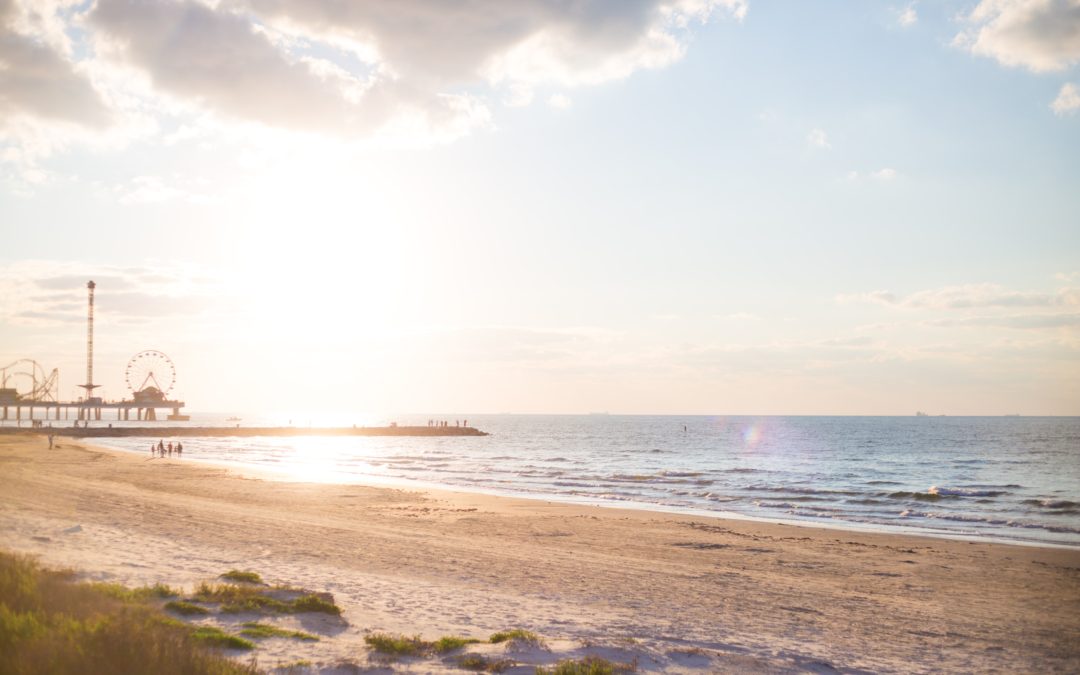For the last five years, I’ve lived on an island.
It’s not the kind of island you might be imagining, with cerulean water, white sands, and resorts for miles; it’s a small barrier island off the upper Texas coast, with surf turned bluish-brown by the currents of the Mississippi and a more humble, unassuming character than the tropical places you see in magazines.
I was born here, and though I was raised primarily on the mainland, I spent summers playing on the island’s beaches, catching buckets of blue crabs and ice chests of speckled trout, and surfing its small, mushy swells. When I was a child I felt such a deep connection to the murky waves that I would say hello and goodbye to them each time I went to the beach, just to make sure they knew I loved them.
My twenties took me as far away as Vermont, North Carolina, and Spain, and then came marriage and children and moves for careers that unexpectedly took us back to the same tiny Texas island where I had spent so much of my childhood.
“Hello,” I couldn’t help but whisper to the water as I drove over the bridge to our new home. “I’ve come back.”
So I’ve been living on an island, and I’ve learned that to live on one is quite different than spending a summer or stopping by for a visit.
The island life is not so much one of traditional seasons, but rather one of endless summer interrupted briefly by hurricane season, tourist season, and a few weeks each of spring, fall, and winter. There are rolling waves of heat and humidity, ameliorated by daily breezes that awaken the palm fronds and blow ethereal clouds of sand across the roads. The most magical time of all is in late September and early October, when the tourists have gone home and the sun isn’t quite so harsh. The beaches suddenly seem endless, the air is buoyant, and we all breathe a collective sigh of relief at the time and space we seem to have regained.
Though our seasons are non-traditional, they require a certain grit to endure. Tourist season calls for both the patience of a saint and deep gratitude for the economic boost. Hurricane season demands vigilance, preparedness, humility, and resolve. For over a hundred years, this resilient little island has been battered by storms that will make you or break you, and probably both. In what seems to me to be the most apropos metaphor for the spirit of the island’s inhabitants, a large cemetery that lines the main boulevard becomes enveloped in bright orange and yellow flowers each year; even the island’s departed souls create beauty out of ashes.
When you least expect it, the island will give you a glimpse of its richness; you just have to keep your eyes and heart open to it.
It took me a long time to figure out what exactly it is that bonds the island’s inhabitants so resolutely. I’d toyed with the notions of a shared history, the experience of surviving a natural disaster, or a love for the beach; but none of these seemed entirely fitting. I’ve concluded that we are bonded to each other here because, quite simply, we all live on a strip of sand that is surrounded by the sea. Mother nature gently cradles our being and periodically threatens to swallow us whole. We can’t help but feel both privileged by the exclusivity of life on an island and humbled by its precariousness. It’s as if we all share the same knowledge that we belong to the waves and the sand, for better or for worse.
The island is dotted with buried treasure, from the legendary bounty of the pirate Jean Lafitte to endangered Kemp’s Ridley sea turtle egg nests. There are unique birds that peek out from the brush of the nature preserves and gorgeous historic buildings that reside nonchalantly on otherwise nondescript streets. There are family-owned businesses whose guiding principles are still honesty and trustworthiness, where even in today’s world you can get a fair deal. Cemeteries full of famous figures, iconic surnames, and many of my own family members sit tucked behind businesses and grocery stores, a trove of quieted heartbeats that walked, built, and served the island. When you least expect it, the island will give you a glimpse of its richness; you just have to keep your eyes and heart open to it.
On seven brief miles of land, there are people from every corner of the globe, an homage to the city’s early-nineteenth-century role as a major immigration port second only to Ellis Island. Now, people come to live here for work in the hospitality industry, at the port, or for the cruise lines. They are here for medical treatment at a highly specialized medical center, or to research infectious diseases. They might be snowbirds or living out their retirement at the beach. Their families were among the first to settle the land, they were born here, they ended up here by fate, or they are just passing through. Like most places, the diversity of social classes and cultures will probably never blend enough to create an idyllic melting pot. Rather, the island hosts a mosaic of individual classes, races, and cultures that mostly manage to peacefully co-exist. While imperfect and messy up close, it does indeed create a beautiful piece of art.
A causeway connects the island to the mainland and all the amenities that come with the urban sprawl of a major city. Yet the longer you live here, the less appealing you find crossing the bridge. We really have almost everything we need, including the year-round entertainment of festivals, performances, quaint but vibrant nightlife, and of course, the beach. To an extent, living on the island makes it hard to relate to the fast-paced, keep-up-with-the-joneses culture so prevalent elsewhere.
If you do venture off the island, when you come home you are likely to experience “The Causeway Effect.” This locally-known phenomenon is the sensation that washes over you as you enter the incline of the southbound lanes over the bay. Your lungs instinctively fill with breath and then exhale with gusto; your shoulders and jaw relax; your heart does a barely-palpable skip, and your thoughts momentarily shift away from the awful complexities of the world. You can’t help but notice the way the sunlight looks like diamonds on the water, the azure sky, or the honor of having pelicans escort you home.
It’s been a privilege to live on this little island in the Gulf. As a local, sometimes I get caught up in the day-to-day hustle of work, children, and other responsibilities, and I forget about how unique my living situation is. I don’t go to the beach nearly as often as I should. But when I do, I always make sure to walk to where the sand is made soft by the sea, curl my toes into the shore, and tell the waves hello – so they know I still love them.



Well written. Elizabeth sent me the link.
I was walking around our little island a few days ago and passed a sign on one of those chalk boards outside a business. “Soup of the day – Whisky”.
That kind of island.
Thank you for reading! It’s a special place indeed.
Beautiful just beautiful!
Thanks!